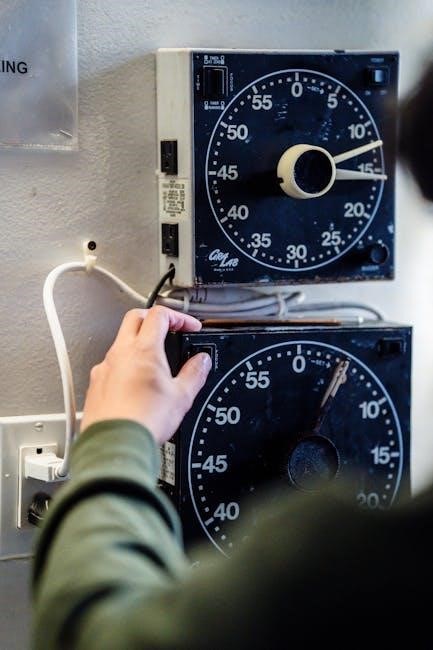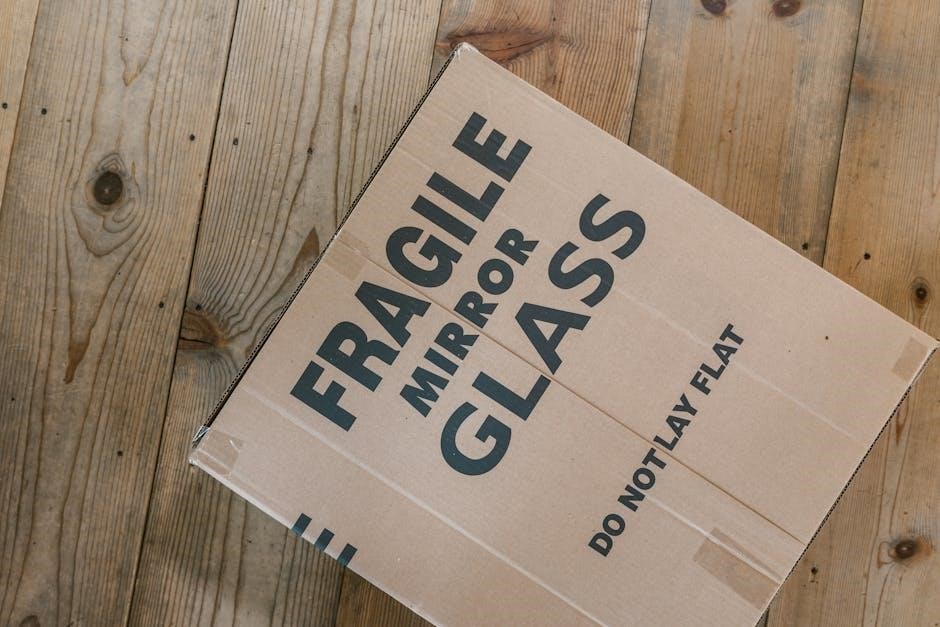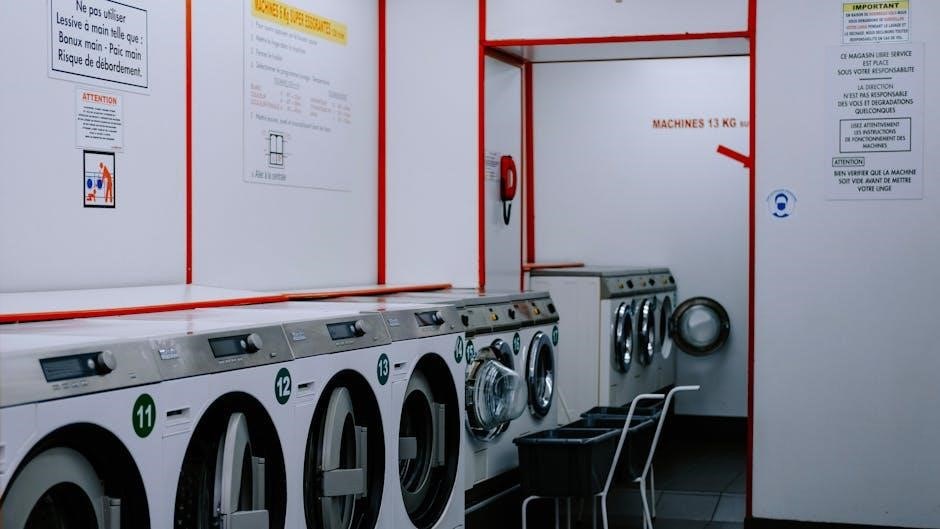
Aube thermostats offer advanced temperature control for electric heating systems, ensuring ease of use and energy efficiency. They provide programmable and non-programmable models with a user-friendly interface.
1.1 Overview of Aube Thermostat Models
Aube offers a range of programmable and non-programmable thermostats designed for electric heating systems. Models like the TH115, TH104, and TH232-AF-230 provide advanced temperature control, while others, such as the TH146-P-2H1C, are known for their user-friendly interfaces. These thermostats cater to various heating needs, including baseboards, radiant floors, and electric convectors. Aube’s product line ensures versatility, with options suitable for both residential and light commercial applications, making them a reliable choice for efficient temperature management.
1;2 Key Features of Aube Programmable Thermostats
Aube programmable thermostats are equipped with advanced features like touchscreens, energy-efficient scheduling, and compatibility with electric heating systems. Models such as the TH115 and TH232-AF-230 offer precise temperature control, while the TH146-P-2H1C includes a built-in clock and day settings. These thermostats also feature vacation mode, remote sensor compatibility, and energy usage reports. Their programmable interface allows users to set custom schedules, optimizing comfort and energy savings. Designed for ease of use, Aube thermostats ensure efficient and reliable temperature management for various electric heating applications.

Safety Precautions
Ensure electrical safety by cutting power before installation. Avoid installing near chimneys or stove pipes. Keep vents clean and ensure proper ventilation for optimal function.
2.1 General Safety Guidelines
Always disconnect power at the main electrical panel before installing or servicing the thermostat. Ensure the device is not installed near chimneys or stove pipes. Resistive loads only should be connected, with a maximum of 4000W at 240VAC or 2000W at 120VAC. Keep the thermostat vents clean and unobstructed for proper operation. The floor sensor must be centered between heater wires with a maximum temperature of 80°C. Follow all national and local electrical codes to ensure safe and effective operation of the thermostat.
2.2 Electrical Safety Tips
Always disconnect power at the main electrical panel before handling the thermostat. Ensure the device is not installed near combustible materials or heat sources. Resistive loads only should be connected, with a maximum of 4000W at 240VAC or 2000W at 120VAC. The thermostat wires are not polarized, so either wire can be connected to the load or power supply. Keep the vents clean and unobstructed for proper operation. Never install on walls concealing chimney or stove pipes to avoid fire hazards. Follow all national and local electrical codes for safe installation and operation.

2.3 Avoiding Common Installation Mistakes
Ensure the thermostat is not installed on walls concealing chimney or stove pipes to prevent fire hazards. Avoid mounting the device near heat sources or combustible materials. Verify the floor sensor is centered between heater wires for accurate temperature sensing. Do not fully remove the mounting screw to maintain proper alignment. Keep the thermostat’s vents clean and unobstructed for optimal performance. Always follow the manufacturer’s guidelines for load specifications and electrical connections to ensure safe and reliable operation. Proper ventilation around the thermostat is essential to avoid overheating issues.

Installation Instructions
Ensure installation is done by a certified electrician, following national and local electrical codes. Always cut power at the main panel before wiring. Use this thermostat for resistive loads only, up to 4000W at 240VAC or 2000W at 120VAC. Proper ventilation and compliance with safety guidelines are essential for reliable operation.
3.1 Tools and Materials Required
To install an Aube thermostat, you will need a screwdriver, wire strippers, and a voltage tester. Ensure you have wall anchors and screws for mounting. Additional materials may include a drill for pilot holes and a level for proper alignment. Always use a voltage tester to confirm power is off before handling wires. Refer to the user manual for specific tools recommended by the manufacturer. Proper preparation ensures a safe and successful installation process.
3.2 Step-by-Step Installation Process
Begin by turning off the power to the heating system at the main electrical panel. Remove the old thermostat and disconnect the wires. Take note of the wire connections for reference. Mount the new Aube thermostat base to the wall, ensuring it is level. Connect the wires to the appropriate terminals as per the manual. Reattach the thermostat faceplate and restore power. Test the thermostat by turning on the heating system to ensure proper operation. Follow the user manual for specific configurations and settings to complete the installation accurately.
3.3 Mounting the Thermostat on the Wall
Turn off the power to the heating system at the main electrical panel. Remove the old thermostat and disconnect the wires. Install the new Aube thermostat base on the wall, ensuring it is level. Use appropriate screws or anchors to secure the base firmly; Reattach the thermostat faceplate and restore power. Ensure the thermostat is not installed near chimneys or stove pipes for safety. Keep the vents clean and unobstructed for proper operation. Follow the manufacturer’s guidelines for wall mounting to ensure stability and accuracy.
3.4 Connecting the Wires Correctly
Ensure the power is off at the main electrical panel before connecting wires. Aube thermostats are compatible with resistive loads up to 4000W at 240VAC or 2000W at 120VAC. Connect the wires to the appropriate terminals, as the thermostat is not polarized. Secure all connections tightly to avoid loose wires. Double-check the wiring diagram in the user manual for specific configurations. Avoid overtightening, which could damage the terminals. Ensure the system is designed for resistive loads, such as electric baseboards or radiant floors, before connecting the wires.

Programming Instructions
Program your Aube thermostat by setting the clock, creating a weekly schedule, and adjusting temperature settings for optimal comfort and energy efficiency year-round.
4.1 Setting the Clock and Day
To set the clock and day on your Aube thermostat, press the Clk button until the hour display flashes. Use the up/down arrows to adjust the time, then press Clk to save. Repeat for the day setting. Ensure the display shows the correct time and day to activate programmable features properly. This step is essential for scheduling temperature changes accurately. Refer to the user manual for additional details on synchronizing the clock with your desired schedule.
4.2 Creating a Weekly Schedule
To create a weekly schedule, press the Clk button to access the schedule menu. Use the up/down arrows to select the desired day and time block. Adjust the temperature settings for each period using the ↑ and ↓ buttons. Repeat this process for all seven days to customize your heating plan. Once completed, press Clk to save your schedule. This feature allows you to optimize your heating usage, ensuring comfort and energy efficiency throughout the week. Refer to the manual for advanced scheduling options.
4.3 Adjusting Temperature Settings
To adjust the temperature settings, press the Set button and use the ↑ and ↓ arrows to select your desired temperature. Press Set again to save. For programmable mode, access the schedule menu to set temperatures for different times. Ensure proper installation and configuration as per the manual. Keep vents clean for accurate readings. Refer to the user manual for advanced features and troubleshooting. Contact Aube support if issues arise.

Operating Modes
Aube thermostats operate in Manual Mode for on-demand temperature changes and Programmable Mode for scheduled settings, optimizing comfort and energy efficiency based on your daily routine.
5.1 Manual Mode Operation
In Manual Mode, the Aube thermostat allows you to adjust the temperature instantly without following a schedule. Simply use the up and down arrows to set your desired temperature. The display shows the current room temperature, enabling precise control. This mode is ideal for temporary adjustments or when you prefer not to follow a programmed schedule. It provides flexibility and immediate comfort by letting you override settings as needed. Manual Mode is user-friendly and ensures effortless temperature management, making it perfect for everyday use or special occasions.
5.2 Programmable Mode Configuration
Programmable Mode allows you to set specific temperature schedules for different times and days. Press the “Clk” button to access the clock and day settings. Use the up and down arrows to adjust the temperature for each programmed period. This mode optimizes energy use by automating temperature adjustments, ensuring comfort and efficiency. Once configured, the thermostat follows the set schedule, but manual overrides are possible for flexibility. This feature is ideal for maintaining consistent temperatures while reducing energy consumption during unused hours.

Troubleshooting Common Issues
Check power supply, wiring connections, and ensure proper installation. Clean vents and verify sensor accuracy. Refer to the user manual for diagnostic steps and solutions.
6.1 Thermostat Not Turning On
If the thermostat fails to turn on, first ensure the power supply is intact. Check the circuit breaker or fuse box to confirm power is not interrupted. Verify that all wiring connections are secure and not damaged. Ensure the thermostat is properly mounted and vents are clean. If issues persist, consult the user manual for diagnostic steps or contact Aube customer support for assistance. Always turn off power before inspecting internal components. Regular maintenance can help prevent such issues.
6.2 Incorrect Temperature Readings
If the thermostat displays incorrect temperature readings, ensure the sensor is clean and unobstructed. Check for proper installation and alignment. Verify that no nearby objects are interfering with the sensor’s accuracy. Clean the vents regularly to prevent dust buildup. If issues persist, recalibrating the thermostat may be necessary. Ensure the thermostat is not located near drafts or direct sunlight, as this can affect readings. Refer to the user manual for calibration instructions. If problems continue, contact Aube customer support for further assistance.
6.3 Thermostat Not Responding to Schedule
If the thermostat fails to respond to its programmed schedule, first ensure the clock and day settings are correct. Verify that the schedule has been saved properly. Check for any power issues or interruptions that may have reset the thermostat to manual mode. Cycle the power by turning it off at the main electrical panel and then turning it back on. Ensure no conflicting settings or overrides are active. Clean the thermostat vents to ensure proper function. If issues persist, refer to the user manual for software updates or contact Aube support for assistance.

Maintenance and Care
Regularly clean the thermostat vents to ensure proper airflow and accurate temperature readings. Check for dust or debris that may obstruct function. Ensure the device is securely mounted and wires are properly connected for optimal performance and safety.
7.1 Cleaning the Thermostat
Regular cleaning is essential for maintaining your Aube thermostat’s performance. Use a soft, dry cloth or a small, soft-bristled brush to gently remove dust or debris from the vents and surface. Avoid using harsh chemicals or liquids, as they may damage the device. Ensure all vents remain unobstructed to guarantee proper airflow and accurate temperature readings; For detailed cleaning instructions, refer to the user manual. Proper maintenance ensures optimal functionality and extends the lifespan of your thermostat.
7.2 Ensuring Proper Ventilation
Proper ventilation is crucial for your Aube thermostat to function accurately. Ensure the thermostat is installed in a well-ventilated area, avoiding obstructions or nearby heat sources. Keep the surrounding walls and floor clear of furniture or curtains that could block airflow. Regularly inspect and clean the thermostat’s vents to prevent dust buildup. Avoid installing the thermostat near chimneys, stovepipes, or radiant heating elements, as this can interfere with temperature readings. Proper ventilation ensures reliable performance and extends the lifespan of your device.

Energy Efficiency Tips
Optimize energy use with Aube thermostats by adjusting temperature settings and utilizing programmable features. Proper scheduling and smart temperature adjustments can significantly reduce energy consumption and costs.
8.1 Optimizing Temperature Settings
Optimizing temperature settings with Aube thermostats involves adjusting the temperature to balance comfort and energy efficiency. Lower the temperature when the house is unoccupied or during sleep hours, and raise it when family members are home. Consider using temperature holds for extended periods away from home. Adjust settings seasonally to account for extreme weather conditions. Ensure the thermostat is not placed near drafts or heat sources, as this can affect accuracy. Regularly review and update your temperature schedule to reflect lifestyle changes and energy-saving goals.
8.2 Using Programmable Features Effectively
Maximize energy savings by utilizing the programmable features of your Aube thermostat. Create a weekly schedule that aligns with your daily routine, setting different temperatures for weekdays and weekends. Use the hold feature to maintain a consistent temperature during extended periods away from home. Adjust the schedule seasonally to account for changing weather patterns. Regularly review and update your settings to ensure they reflect your current lifestyle and energy goals. This ensures optimal comfort while minimizing energy consumption.

Manufacturer Support and Resources
Aube provides comprehensive support through online user manuals, customer service contact options, and troubleshooting guides to ensure optimal use of their programmable and non-programmable thermostats.
9.1 Accessing User Manuals Online
Aube thermostat user manuals are readily available online, providing detailed instructions for installation, programming, and troubleshooting. These manuals can be downloaded in PDF format from the Aube website or support pages. They include essential information such as safety guidelines, warranty details, and technical specifications. Users can access manuals for specific models like the TH115 or TH104, ensuring compatibility with their thermostat. Always consult the manual for your particular model to ensure proper configuration and safe operation.
9.2 Contacting Aube Customer Service
Aube customer service provides support for thermostat-related inquiries, including installation, programming, and troubleshooting. Users can contact Aube via phone, email, or through their official website. The customer service team is available during business hours to assist with technical issues or product information. For efficient support, have the thermostat model number and a detailed description of the issue ready. Aube also offers online resources and FAQs to help users resolve common problems independently. Their dedicated team ensures timely and effective solutions for optimal thermostat performance.
Proper installation and maintenance ensure optimal performance and energy savings with Aube thermostats. Follow the guidelines for efficient temperature control and extended product lifespan.
10.1 Summary of Key Instructions
Ensure installation by a certified electrician, following safety guidelines. Set the clock and day, then create a weekly schedule with temperature adjustments. Maintain clean vents and sensors for accuracy. Troubleshoot issues like no power or incorrect readings by checking connections and settings. Optimize energy use by adjusting temperature settings. Refer to the user manual for detailed troubleshooting and configuration. Regular cleaning and proper ventilation ensure long-term efficiency and reliability of your Aube thermostat. Follow these steps for safe, effective, and energy-efficient operation.
10.2 Final Tips for Effective Use
Regularly clean the thermostat’s vents and sensors for accurate temperature readings. Schedule maintenance checks to ensure optimal performance. Use programmable features to optimize energy savings. Adjust temperature settings based on seasonal changes. Keep the thermostat away from direct sunlight or drafts. Update your thermostat’s software, if applicable, for improved functionality. Monitor energy usage patterns to refine your settings. Always refer to the user manual for specific model instructions. By following these tips, you can maximize efficiency and enjoy consistent comfort with your Aube thermostat.